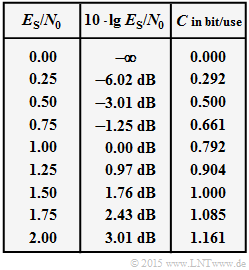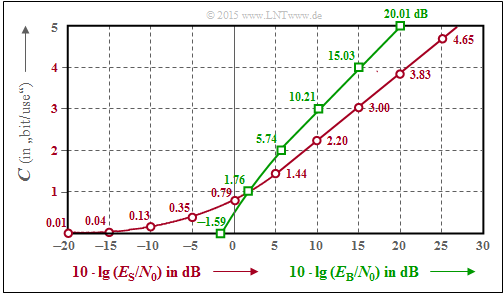Exercise 4.8: Numerical Analysis of the AWGN Channel Capacity
There are two different equations for the channel capacity $C$ of the AWGN channel as an upper bound for the code rate $R$ in digital signal transmission:
$\text{Channel capacity C as a function of energy per symbol}$:
- $$C( E_{\rm S}/{N_0}) = {1}/{2} \cdot {\rm log}_2 \hspace{0.1cm} ( 1 + \frac { 2 \cdot E_{\rm S}}{N_0}) .$$
Here, the following abbreviations are used:
- $E_{\rm S}$ denotes the (average) energy per symbol of the digital signal,
- $N_0$ indicates the AWGN noise power density.
$\text{Channel capacity C as a function of energy per bit:}$:
- $$C( E_{\rm B}/{N_0}) = {1}/{2} \cdot {\rm log}_2 \hspace{0.1cm} ( 1 + \frac { 2 \cdot R \cdot E_{\rm B}}{N_0}) .$$
- The relation $E_{\rm S} = R \cdot E_{\rm B}$ has to be considered, where $R$ is the code rate of the best possible channel coding.
- Error-free transmission (with optimal code) is possible for the given $E_{\rm B}/N_0$ as long as $R \le C$ ⇒ Shannon's channel coding theorem holds.
Given by the table is the curve of channel capacity as a function of $E_{\rm S}/N_0$. The focus of this exercise is the numerical evaluation of the second equation.
Hints:
- The exercise belongs to the chapter AWGN channel capacity with discrete value input.
- Reference is made in particular to the pages
- Since the results are to be expressed in "bit", "log" ⇒ "log2" is used in the equations.
Questions
Solution
- Based on the equation
- $$C = {1}/{2} \cdot {\rm log}_2 \hspace{0.1cm} ( 1 + { 2 \cdot E_{\rm S}}/{N_0}) $$
- we obtain with $C = R$ and $E_{\rm S} = R · E_{\rm B}$ the equation according to solution suggestion 1:
- $$R = {1}/{2} \cdot {\rm log}_2 \hspace{0.1cm} ( 1 + { 2 \cdot R \cdot E_{\rm B}}/{N_0})\hspace{0.05cm}. $$
- Bringing the factor $1/2$ to the left side of the equation and forming the power to the base $2$, we get the suggestion 2:
- $$2^{2R} = 1 + 2 \cdot R \cdot E_{\rm B}/{N_0}\hspace{0.05cm}. $$
- If we solve this equation for $E_{\rm B}/{N_0}$ , we get
- $$E_{\rm B}/{N_0} = \frac{2^{2R} - 1} { 2 R} \hspace{0.05cm}. $$
(2) Error-free transmission is possible over a channel with channel capacity $C$ as long as the code rate is $R ≤ C$ .
- The absolute limit is obtained in the limiting case $C=R = 0$.
- Or more precisely: for an arbitrarily small positive $ε$ , the following must hold: $C=R =ε$ with $ε → 0$.
- Using the result of subtask (1) , the governing equation is:
- $${\rm Min}\hspace{0.1cm}\big[E_{\rm B}/{N_0}\big] = \lim\limits_{R \hspace{0.05cm}\rightarrow \hspace{0.05cm}0}\frac{2^{2R} - 1} { 2 R} \hspace{0.05cm}. $$
- Since here the quotient in the boundary transition $ R → 0$ yields the result "0 divided by 0", ist hier die l'Hospital's rule is to be applied here:
Differentiate numerator and denominator, form the quotient and finally put $R = 0$ . - With $x = 2R$ the result is:
- $${\rm Min}\hspace{0.1cm}\big[E_{\rm B}/{N_0}\big] = \lim\limits_{x \hspace{0.05cm}\rightarrow \hspace{0.05cm}0}\frac{2^{x} - 1} { x} = \frac{{\rm ln}\hspace{0.1cm} (2) \cdot 2^{x} } { 1} \hspace{0.05cm}\bigg |_{x=0} = {\rm ln}\hspace{0.1cm} (2) \hspace{0.15cm}\underline{= 0.693} \hspace{0.05cm}.$$
(3) In logarithmic form, we obtain::
- $${\rm Min}\hspace{0.1cm}\big[10\cdot {\rm lg} \hspace{0.1cm}(E_{\rm B}/{N_0})\big] = 10\cdot {\rm lg} \hspace{0.1cm}(0.693) \hspace{0.15cm}\underline{= -1.59\,{\rm dB}} \hspace{0.05cm}. $$
(4) Thus, the abscissa value in non-logarithmic form is: $E_{\rm B}/{N_0} = 1$. It follows with $C=R$:
- $$\frac{2^{2C} - 1} { 2 C} \stackrel{!}{=} 1 \hspace{0.3cm}\Rightarrow\hspace{0.3cm}\underline{C = 0.5} \hspace{0.05cm}. $$
(5) For $R = 1$ $E_{\rm B} = E_{\rm S}$. Therefore:
- $$ C(E_{\rm B}/{N_0}) = 1 \hspace{0.3cm}\Longleftrightarrow \hspace{0.3cm} C(E_{\rm S}/{N_0}) = 1 \hspace{0.05cm}.$$
- From the table on the information page we can read:
- $$ C(E_{\rm S}/{N_0}) = 1 \hspace{0.3cm}\Rightarrow \hspace{0.3cm} E_{\rm S}/{N_0} = 1.5 \hspace{0.3cm}\Rightarrow \hspace{0.3cm} \underline{E_{\rm B}/{N_0} = 1.5}\hspace{0.05cm}.$$
- The corresponding dB value is $10 \cdot \lg (E_{\rm B}/{N_0}) = 1.76 \ \rm dB$.
- The same result is obtained with $R = 1$ via the equation
- $$E_{\rm B}/{N_0} = \frac{2^{2R} - 1} { 2 \cdot R} = \frac{4 - 1} { 2 } = 1.5 \hspace{0.05cm}.$$
(6) Proposed solution 2 2, is correct, as will be shown by an example:
(a) The channel capacity $C$ for $10 \cdot \lg (E_{\rm B}/{N_0}) = 15 \ \rm dB$ ⇒ $\E_{\rm B}/{N_0} = 31.62$ is sought.
- Then, according to the proposed solution 1 with $x = 2C$:
- $$31.62 = \frac{2^{x} - 1} { x} \hspace{0.3cm}\Rightarrow \hspace{0.3cm} 31.62 \cdot x = 2^{x} - 1 \hspace{0.05cm}. $$
- The solution $x = 7.986$ ⇒ $C = 3.993 \ \rm (bit/use)$ can only be found graphically or iteratively.
(b) The necessary abscissa value $10 \cdot \lg (E_{\rm B}/{N_0})$ for the capacity $C = 4 \ \rm bit/symbol$ is sought:
- $$E_{\rm B}/{N_0} = \frac{2^{2C} - 1} { 2 \cdot C} = \frac{2^8 - 1} { 8 } = 31.875 \hspace{0.3cm}\Rightarrow \hspace{0.3cm} 10\cdot {\rm lg} \hspace{0.1cm}(E_{\rm B}/{N_0}) = 15.03\,{\rm dB} \hspace{0.05cm}.$$
The graph shows the AWGN channel capacity as a function of
- $10 \cdot \lg (E_{\rm S}/{N_0})$ ⇒ red curve and numbers;
these indicate the channel capacity $C$ for the given $10 \cdot \lg (E_{\rm S}/{N_0})$ ; - $10 \cdot \lg (E_{\rm B}/{N_0})$ ⇒ green curve and numbers;
these indicate the required $10 \cdot \lg (E_{\rm S}/{N_0})$ for the given channel capacity $C$ .
The intersection of the two curves is at $1.76\ \rm dB$.

